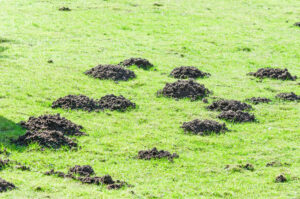
Ground moles can be a real headache for gardeners who take pride in their flowerbeds. These burrowing critters might not seem like a big threat but can cause significant disruptions to the landscape you’ve carefully nurtured. When moles make your flowerbeds their new home, they create tunnels that can damage plant roots, leading to wilted flowers and bare patches. Their underground activities can take away the charm and aesthetic appeal of your garden, making it important to handle the issue promptly.
As you gear up for the summer season, it’s crucial to be aware of the steps you can take to protect your flowerbeds from mole damage. By understanding the signs of an infestation, you can take the right actions and keep your garden looking vibrant and healthy. Let’s delve into how to recognize mole damage and protect your beloved flowerbeds.
Identifying Ground Mole Damage
Figuring out whether moles are causing trouble in your garden can help you address the problem effectively. Moles often leave a series of tell-tale signs. These insights will guide you to recognize mole activity and take the necessary steps.
Here’s what to look out for:
– Mounds of Dirt: One of the most obvious signs is molehills—small mounds of dirt that appear suddenly. These piles indicate where a mole has been active, pushing soil to the surface while digging.
– Raised, Uneven Ground: Moles create networks of tunnels just below the surface. This can lead to parts of your flowerbeds becoming raised or uneven, making it difficult to maintain a level garden.
– Wilting Plants: As moles destroy the root systems of your flowers, plants can begin to wilt or show signs of distress. If plants in a particular area are withering with no clear reason, moles may have disturbed their roots.
It’s essential to distinguish mole damage from other pest activities. For example, voles or rabbits might chew on plant stems but don’t create large underground tunnels. Understanding these subtle differences can help in deciding how best to handle the situation. Certain areas, especially those with rich, soft soil, tend to attract moles because they make for easier digging. By recognizing which sections of your flowerbeds are most susceptible, you can be better prepared to address mole intrusions when they arise.
Immediate Steps to Protect Your Flowerbeds
Once you spot signs of moles in your flowerbeds, acting quickly can prevent further damage. Start by inspecting the area thoroughly to confirm mole activity. Look for fresh mounds and raised tunnels to understand the extent of the intrusion. Temporarily relocate vulnerable plants if needed, especially those showing signs of stress. Make sure to place them in containers or parts of your garden that aren’t affected, keeping them safe from root damage.
For those who prefer fencing, a physical barrier can protect flowerbeds. Installing a wire mesh or similar material several feet underground may block moles from reaching their favorite spots. Be sure to select a material sturdy enough to deter moles but safe for plants. This solution works well for smaller garden sections or particularly prized plants.
Try these quick tips to safeguard your flowerbeds:
– Water: Keep the soil moist. Moles dislike overly wet soil, so watering could persuade them to look elsewhere.
– Vibrations: Use simple vibration devices around affected areas. Moles are sensitive to ground vibrations, which can coax them to move on.
– Odors: Certain natural repellents like castor oil or peppermint can be sprinkled around your garden, providing an extra layer of deterrence.
These steps offer a short-term fix, allowing some temporary peace for your garden. But for long-lasting results, it’s wise to consider more conclusive strategies.
Long-Term Solutions for Mole Control
To maintain a beautiful, mole-free garden over the long term, focusing on prevention is key. It’s important to create an environment that’s less appealing to moles. Start by reducing the availability of insect prey, like grubs and earthworms, as these are key attractions for moles. Some gardeners choose to introduce beneficial nematodes to help naturally reduce grub populations in the soil.
In addition to altering the garden environment, integrating professional trapping solutions might be the most effective path to eliminating persistent mole issues. Professional services bring in expertise and tools designed specifically to handle mole problems efficiently. By using humane trapping methods, you can ensure that you remove moles without resorting to harmful chemicals or invasive techniques.
Lastly, consider incorporating natural deterrents into your landscape design. Planting plants such as daffodils or marigolds may deter moles while adding beauty to your garden. These plant-based solutions contribute to a balanced ecosystem and can reduce the likelihood of reinfestation.
Reflecting on the Road to Recovery
Taking on the challenge of mole removal might seem daunting, but taking the right steps can lead to a healthier and more flourishing garden. You can start with quick fixes for immediate relief, then transition into more permanent solutions that suit your long-term goals. The combination of quick action, preventative measures, and expert assistance will provide a strong foundation against pesky moles.
Remember, maintaining a mole-free garden is not just about fighting the current problem; it’s about creating an environment that thrives. As you nurture your garden back to health, patience and vigilance will play significant roles. With a bit of perseverance, you’ll reclaim your flowerbeds, ensuring they remain a beautiful and joyful part of your home.
Ready to enjoy a mole-free garden and restore your flowerbeds to their former beauty? Get reliable help with the removal of ground moles from Trap Your Moles. Our expert services can help reclaim your lawn and keep it looking its best. Reach out now to get started.






